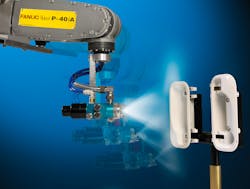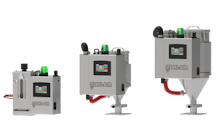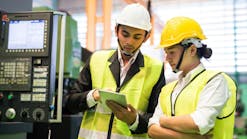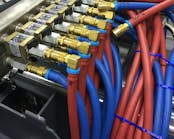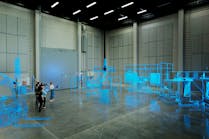While plastics processors frequently integrate robots and automation into their operations to improve efficiency, automation also can play a role in improving worker health and safety.
“I wouldn’t call it a side benefit,” said Raul Scheller, managing director for North America for the Sepro Group. “Companies are looking at their operations, safety, quality, output, effectiveness, efficiencies, and every one of them plays a key role. The robot provides benefits across the board, including safety.”
Besides reducing injuries from lifting and repetitive stress, robots have attracted attention and sales this year by helping to address the spread of the coronavirus.
“In today’s world, robots will eliminate operators from being in close contact with each other and the risk associated with the pandemic,” said Jim Healy, VP of sales and marketing at Sepro America, which sells three-, five- and six-axis robots, as well as sprue pickers.
Health experts recommend workers stay a minimum of 6 feet apart, but, in crowded facilities, that can be difficult.
“With the pandemic, if you talk about 6 feet, there are cases where the molding machines are within 6 feet of each other or you might have multiple operators at one press,” Scheller said.
Sepro has seen customers specifically buying robots or accelerating planned purchases of robots to address concerns about the pandemic and worker distancing, Healy said.
The company is not alone.
“If you put automation in your facility, you allow yourself to spread out your workforce,” said Tim Lavigne, business unit manager for Absolute Robot Inc., which distributes automation solutions.
Many facilities have two employees working on a single press. One might be removing parts while the other one de-gates or packages parts. Robots can streamline this process.
“All of a sudden, you’ve got one person at each press or one person tending to two or three different presses,” Lavigne said. “That allows you to have your human capital or your workforce socially distanced within the facility. It’s nothing we ever really thought of up until 2020.”
Universal Robots, which manufactures collaborative robots, also has seen an increase in manufacturers relying on automation to meet social distancing requirements.
“A lot of manufacturing plants are really struggling with social distancing on the plant floor, particularly in injection molding,” said Joe Campbell, Universal Robots’ senior manager of strategic marketing and application development. “You just don’t casually re-lay out a floor and start moving equipment around. The disruption and the cost is prohibitive. It’s even further compounded if you don’t have the space to move into. A lot of these plants are landlocked. It’s not like you can just slap an addition on even if you had the capital to do it.”
A labor shortage already had many plastics processors planning to purchase automation, but the pandemic accelerated buying schedules, Scheller said.
Another typical situation where robots can prevent injuries is part removal.
“In molding, you’re basically melting plastic, and it could be 200 to 600 degrees [Fahrenheit],” said Jason Long, national sales manager of robots and automation for Wittmann Battenfeld. “But the other thing is, when you have to reach into a mold area to get a part that is not being pulled by a robot, you have the chance of touching the mold that has heat still in it.”
Robots also can spare workers from tasks that can cause dust, such as deburring.
“There was one [robot installation] involving sanding, where dust comes up,” Scheller said. “Now, you’re eliminating the operator from breathing dusty particles for 8 hours a day.”
Universal Robots reports that its cobots sometimes are deployed specifically to free humans from working in dusty environments.
“We do a lot of polishing applications that can actually take an operator out of a dust-laden environment,” Campbell said.
For example, Universal Robots works with a company that manufactures high-end audio speakers and cabinets. One of the products features a plastic speaker case that is polished “to an absolute sheen,” Campbell said. “The robot does the initial buffing and polishing, and then I hear an operator finishes it off.”
One of the most common applications for basic pick-and-place Yushin robots that has safety implications is parts removal, said Chris Parrillo, national sales manager for Yushin America.
“Robots enter into the mold area to extract parts. This area may have high surface temperatures and rough or sharp surfaces that could possibly injure the employee,” Parrillo said. “The robot can safely extract the parts from the mold without requiring the operator to have any interaction inside the mold itself, which could cause them harm.”
An operator of a large-tonnage machine might have to place his or her entire body between the mold halves to remove parts or place inserts into the mold, he said.
In other instances, a worker might have to insert sharp blades or needles into the mold. Using robots eliminates the risk to workers.
“We’ve worked on applications where the inserts themselves are very sharp, such as knife blades or pointy needles for medical applications,” Parrillo said. “Obviously, any of those types of inserts can pose a dangerous situation for an operator that has to handle them and try to manipulate them to get them into the mold for proper overmolding.
“Robots can safely place parts onto a worktable or conveyor at an appropriate ergonomic working height, which enables the employee to safely access the parts without having to reach too far, overextend themselves, or bend over to pick up parts that may have fallen from the machine and be at floor level.”
Sepro’s Scheller said tasks like unloading a molding machine or snipping runners by hand can lead to boredom, which also can contribute to injuries.
Using robots to perform repetitive tasks, like trimming or sorting parts, can reduce injuries such as carpal tunnel syndrome. A robot, unlike a human, can continuously and with consistency perform the same task 24/7, 365 days a year, he said.
Other such tasks include quality inspection, de-gating, assembly and packaging, Parrillo said. The robot can do this type of work right beside the press, eliminating the need for a person to transport parts to another location for secondary work.
“It helps whenever they can do the work right there at the machine and not have to take multiple steps moving parts around — even for the finished products,” he said. “Stocker systems and conveyor systems that work alongside the robot can be used to reduce the need for workers to have to lift or carry heavy totes or boxes. The stocker systems are set up so the operator can place stacks of empty containers into the system at a safe height and the system itself will properly orient and unstack those containers, populate the molded product into the containers, restack them and then present them at a safe height for employees or even automated guided vehicles to safely remove the finished product and take it to a shipping dock or another area of the facility.”
Tasks such as de-gating or trimming parts manually also can cause fatigue.
“If someone were trying to use a hand-held heated nippers or some kind of saw mechanism, anytime those elements are present is an opportunity for someone to get hurt or cut themselves,” Parrillo said. “The use of guillotine-style cutters, laser de-gating or rotary blades are all viable safe solutions for automatic de-gating to cut the runner system off without any human interaction.”
Jim Cooper, manager of executive sales and executive director of global accounts at Fanuc America, said articulated robots can be particularly useful when it comes to machine tending because of their flexibility.
“Fanuc’s articulated robots are a great option for mold machine tending because they can perform insert loading and part extraction and have the multi-axis dexterity to perform secondary operations, such as trimming, assembly, labeling, and packing,” he said.
While properly installed robotic systems can improve worker safety and health, precautions — such as safety fencing or light curtains limiting access to robots — are required to keep workers from being hurt.
Cooper also suggests cobots.
“In addition to how the use of robots can improve work cell and operator safety, an additional approach to this can now be potentially utilized using collaborative robots,” Cooper said. “In some applications, this can eliminate the need for safety fencing and even allow for human-robot interaction, if 100 percent automation cannot be achieved.”
Bruce Geiselman, senior staff reporter
For more information:
Absolute Robot Inc., Worcester, Mass., 508-792-4305, www.absoluterobot.com
Fanuc America Corp., Rochester Hills, Mich., 888-326-8287, www.fanucamerica.com
Sepro America, Warrendale, Pa., 412-459-0450, www.sepro-group.com
Universal Robots USA Inc., Ann Arbor, Mich., 844-462-6268, www.universal-robots.com
Wittmann Battenfeld Inc., Torrington, Conn., 860-496-9603, www.wittmann-group.com
Yushin America Inc., Cranston, R.I., 401-463-1800, www.yushinamerica.com
Bruce Geiselman
Senior Staff Reporter Bruce Geiselman covers extrusion, blow molding, additive manufacturing, automation and end markets including automotive and packaging. He also writes features, including In Other Words and Problem Solved, for Plastics Machinery & Manufacturing, Plastics Recycling and The Journal of Blow Molding. He has extensive experience in daily and magazine journalism.

